Let us also pray for the Jews: That our God and Lord may illuminate their hearts, that they acknowledge Jesus Christ is the Saviour of all men.
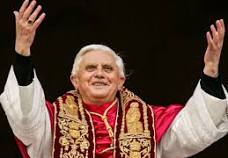
Almighty and eternal God, who want that all men be saved and come to the recognition of the truth, propitiously grant that even as the fullness of the peoples enters Thy Church, all Israel be saved. Through Christ Our Lord. Amen. Good Friday Prayer sanctioned by Benedict XVI.
I always impose a riddle when I construct each of my blogs trying not to repeat myself, and I prepare them months before they appear. This riddle was formulated in September. Therefore “On the Seventh Day” was a play on the Six Day War. There was an irony underlying the aftermath of the Six Day War. The seventh day was a day of rest traditionally for us Christians. So, its use is just coincidence with the assault on Israelis by the Hamas. Yet if it had not been this War, the title would have little relevance.
But not being a creationist, I do not believe that God worked on such an earthly timetable; the title of this blog was a metaphor for UN Resolution 242, which called for:
- The establishment of a “just and lasting peace in the Middle East” with implied mutual recognition.
- Israeli withdrawal “from territories occupied” during the war
- The right of all states – including Israel – to live in peace within “secure and recognized boundaries” that includes “guaranteeing the territorial inviolability and political independence of every state.”
- “A just settlement of the refugee problem.”
In other words – Resolution 242, the seventh day metaphor.
This followed the Six-Day War, where Israel destroyed an Arab attempt to take over Israel. To avoid accusations of bias, I quote a Jewish narrative: The tensions and incidents leading up to the Six-Day War were highlighted by repeated calls by Arab leaders for the destruction of Israel, Egypt blockading an international shipping lane and the decision by the UN to cave in to Egyptian demands to remove international peacekeeping troops from the Sinai with a subsequent massive military build-up on the Israeli border.
With Arab armies massing on its borders and Arab leaders threatening genocide, Israel launched a pre-emptive strike on June 5, 1967. Six days later the war ended with Israel having captured the Golan Heights, the west bank of the Jordan River, the Gaza Strip and the Sinai Peninsula.
With the Arabs having suffered a crushing defeat, the Arab League met in September and issued the Khartoum Resolution with the infamous “Three Noes” in which the Arab League declared “no peace with Israel, no recognition of Israel, no negotiations with it.”
During the period since independence, the Zionists were as ruthless towards their neighbours and those whose lands they expropriated as the Arabs had been in the years leading up to the Six Day War. This hatred has been institutionalised on both sides, except for brief periods.
The UN Security Council Resolution 242 was adopted on November 22, 1967 and with it the hope for eventual peace between Israel and the Arabs. The resolution was followed by a UN peace mission lead by Swedish diplomat Gunnar Jarring to try and implement 242. His efforts culminated with a peace proposal presented in 1971, but failure to agree on how to implement it was finally shattered when Egypt and Syria attacked Israel on Yom Kippur in 1973 – the holiest day in the Jewish calendar. It is not a coincidence that the Hamas launched their attack on a Jewish holiday, Shemini Atzeret.
In 1988 the PLO accepted Resolution 242 in its declaration of independence. The word “Palestinian” was not used in Resolution 242. At the time the PLO did not explicitly recognize Israel nor call for a peace treaty nor a two-state solution, but instead accused Israel of seeking the “extermination of the Palestinian people.” Yet in 1993, Israel and the PLO signed the Oslo Accords.
Israel has set up a technocratic country with the outward appearance of a European democracy. I am aware of a Voltaire comment. Voltaire said that he wondered whether Prussia was an army with a state rather than a state with an army. The basis of this comment was that Prussia was surrounded by hostile forces, whose foreign policy was to destroy this emerging European power. Prussia did not have the overwhelming support of an external power, as Israel has with the US. Yet the words of Voltaire seem very relevant today.
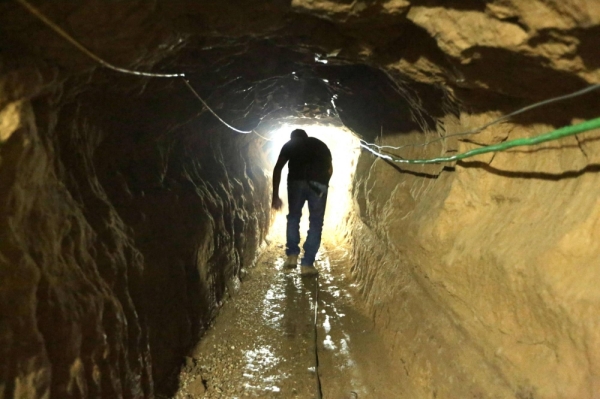 As I have foreshadowed, what will Netanyahu do after levelling Gaza in his search for what is apparently a very highly technically advanced tunnel system under Gaza, leaving a passel of Hamas fighters very protected, while ensuring with the blessing of the USA that every Gazan is killed, including the systematic killing of children. Netanyahu seems to be emulating a version of what the Romans did to Carthage, sowing the land with salt; Netanyahu is creating mountains of rubble. How is Netanyahu going to delight his far-right constituency enshrouded in black and hatred as they do their ritual prancing. I for one was not particularly enchanted by the sight of these people spitting at Christians. What a good idea, kill every Palestinian Christian as well.
As I have foreshadowed, what will Netanyahu do after levelling Gaza in his search for what is apparently a very highly technically advanced tunnel system under Gaza, leaving a passel of Hamas fighters very protected, while ensuring with the blessing of the USA that every Gazan is killed, including the systematic killing of children. Netanyahu seems to be emulating a version of what the Romans did to Carthage, sowing the land with salt; Netanyahu is creating mountains of rubble. How is Netanyahu going to delight his far-right constituency enshrouded in black and hatred as they do their ritual prancing. I for one was not particularly enchanted by the sight of these people spitting at Christians. What a good idea, kill every Palestinian Christian as well.
I do not condone war. I do not condone brutality. I do not condone torture. I am ashamed of former Australian Prime Ministers being seduced by the Zionists to sign a Netanyahu panegyric. At least Gillard should have known better. Paul Keating to his credit refused.
In many ways the USA has led the modern world, including Australia into a morass where any moral compass has been lost. In any comments, nobody would condone what Hamas did, any more than actions depicted in those confronting images provided by ISIS showing what they did to their prisoners during the Iraq conflict would be condoned.
Much of this criminal behaviour is done in the name of religion. My fellow Australians condone what is happening in Gaza by a group of adherents who constitute 0.4 per cent of our population, who seem collectively to be cheering one of the monstrous perpetrators in this morass, Bibi Netanyahu. We with connivance of the media have allowed a range of stunted sociopaths to glimmer in this morass trickling towards Armageddon.
I doubt if anyone is listening to Benedict, but his prayer at least was not written by the Zionists.
White Jews of Kerala
I first went to Kerala at the end of 1983. I had watched a Malcolm Muggeridge documentary about India. He inspired my desire to go to India, and particularly to sit in the Viceroy’s Chair in Simla, the hill station for Britons fleeing the Delhi heat in summer. Simla is nestled in the foothills of the Himalayas. That was one action of his that I did not achieve. I went to Simla in the middle of winter and that was a remarkable trip to Himachal Pradesh from New Delhi.
Muggeridge created another image of India. He stood on a beach in Southern India, which he identified as Kerala. I had never associated palm trees and sandy beaches with India. This only served to confirm my intention to go and stand on a beach in Kerala with arms outstretched in the seductive atmosphere of Southern India as Muggeridge had done. My eventual stint turned out to be a month when I travelled the length of India. When I had landed in Bombay, as it was then called, I wondered why I was there. By the end of that month, I knew!
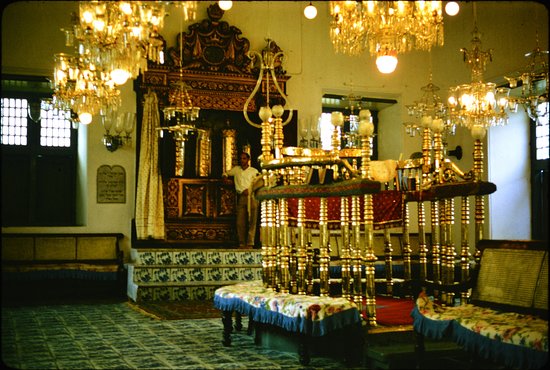
Beaches were not the other reason to attract one to Kerala, a state with a significant Christian population that votes Communist. It is its diversity. I had heard that there was a Jewish community in Cochin, called the White Jews of Kerala. Along a narrow street, to which we had been directed, there was a nondescript building. Behind the façade was the Paradesi Synagogue, which had been constructed in the 16th century by a group of Sephardic Jews who had come from Portugal. There had been a group of Jews there before. These were named Black Jews, the origin being more problematical and whom the “invading” White Jews prohibited from becoming full members of the White Jew synagogue.
When we visited the synagogue, there was an old man who acted as the caretaker. A White Jew – he frankly did not have any distinguishing features from those of any other South Indian I had met. He remembered a rabbi, but that was long ago. Still, he said that the White Jews had a minyan – just. Most of the White Jews had left – gone to Israel. He was old, as were those who stayed, and he recognised clearly that soon there would be no more White Jews. He showed us the synagogue, which had been well kept. He told us not to take photographs but sold us a postcard.
This showed the image which fixed our gaze when we had sat on one of the benches – a golden image of the raised platform where the service is led and where the Torah is read, being freestanding and roughly situated in the middle of the sanctuary and the ark (called the hekhal by Sephardim). The hekhals are essentially cabinets or armoires storing the sefer Torahs along the wall that is closest to Jerusalem.
There was a ner tamid or oil lamp hanging in front of the Ark; the tables of the Law surmount it. The seven-branched candlestick, the menorah, was placed at the side. It was only the second time I had been in a synagogue, although I have had many Jewish colleagues.
When I went back to the Paradesi synagogue years later, the White Jews were no more and the synagogue was now a tourist attraction, which one had to pay to enter. I did not want to see the relic of a vibrant religious community. I reflected how I had been privileged, meeting one of the last White Jews in a working synagogue.
In the Fast Lane
Some years ago, I did a regular locum for a couple of Polish doctors. They were Jewish, and he was in the Polish army during World War 2. He had not been recognised as a Jew. He thus avoided being sent to a concentration camp. However, that did not exempt him from brutality by the guards in his POW camp, and he was never keen on Latvians, but that is another story. Anyway, as he recounted to me, one day in the prison camp he was deprived of any food and drink. He said that he was able to find out the date. It was Yom Kippur.
A Lesion in Brevity
For several years, I have been playing around with the challenge of writing a short story in less than 500 words. I intended writing a quintet as I had done for the Kimberley, and car accidents. The first drew their inspiration from my trip round the Kimberley in 1979, but my five short stories were hardly Ion Idriess; the second quintet I wrote after I had a nasty car accident driving near Shepparton on a cold rainy winter’s night in 1981; and the third on episodes tied into religion. As with the other sets, it was supposed to contain five short stories, but along the religion trail, I had run out of inspiration.
Thus, I just embellished a visit I had made.
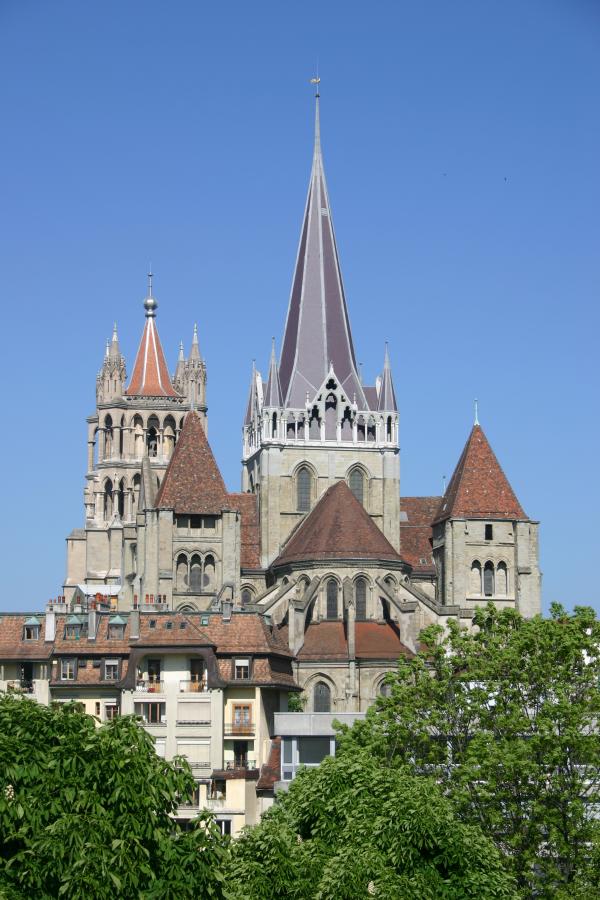 When visiting the Cathedral of Notre Dame located in the city of Lausanne, a Roman Catholic Church confiscated by the local Evangelical Church – a Calvinist offshoot, I saw an exercise in flamboyant religiosity, which I translated into the 370 word narrative below which I entitled: Oblivia – A short play with words:
When visiting the Cathedral of Notre Dame located in the city of Lausanne, a Roman Catholic Church confiscated by the local Evangelical Church – a Calvinist offshoot, I saw an exercise in flamboyant religiosity, which I translated into the 370 word narrative below which I entitled: Oblivia – A short play with words:
For her she had come for Inspiration.
She, the lady in the crimson turban and gathered pleats threw up her arms and then prostrated herself before the altar. It was a small stage, there were no saints alive in the rose window above her. A window held true to its 13th century countenance as sketched by Villard de Honnecourt; as constructed by Pierre d’Arras. An Imago mundi which Oliver Cromwell would never have countenanced in the Protestant acquisition had he been allowed to get out of his Albion cage. So he would not have she decided.
A vague thought, but not “nouvelle”.
She did not see her companion fall down, striking his head on the stone floor. It was academic whether the fall preceded the fit; or not.
She did not hear the head strike the floor.
She remained prostrate. Precisely on the stroke of the 120 “cat-and-dogs” mantra, she raised herself to a kneeling position and carefully flicked the crucifix from the pleats.
Her companion was bleeding from the right ear – unseeing eyes beneath increasingly blue-tinged eyelids – body quivering in the throes of grand mal epilepsy. Body askew on two levels. The head on the step – the body across the flag stones. Not particularly good for maintaining the airway.
The earplugs in her ears as she listened to the Tallis motet Spem in allium made communication difficult, especially as the videte miraculum had just commenced.
Her companion was dusky and his sounds were of one choking.
She crossed herself – an extravagant flourish considering the Calvinist surroundings – stood up only to genuflect – then plunged into a kneeling position, head upturned towards the Inspiration.
The workers fixing the heating system in the Grand Bay of the Cathedral had dropped their tools and run the length of the nave to the fallen person. One rolled her companion over; another had run back to where the mobile phone had been left and called the ambulance. One worker was wrestling with the airway; could the colour be reversed? Another had fingers on the radial pulse. The fitting had stopped; the eyes remained without recognition. The light filtering down from the rose window elicited no response.
For him, he was left with no Inspiration.
OK, this was a serious literary conceit. This past year I was challenged to write a short story in 100 words where you get 10 per cent leeway – thus 110 words max. I responded with an anecdote (micro-story) derived from my childhood entitled “Green to Red”.
The aunt’s villa had a long corridor. On the left side people lived; on the right, the doors were locked. One day the small boy found one door unlocked. He peeped in and saw a mass of green-inked paper. The hand on the shoulder. She hissed: don’t go in, there are carpet pythons. He pulled back, scared. Years later he learnt there were no carpet pythons, never had been; but why wasn’t he allowed to go into that room? He went back to the villa, now empty. Doors were locked, except one. The paper was still there, but red-inked. He felt something on his shoulder. It hissed in his ear.
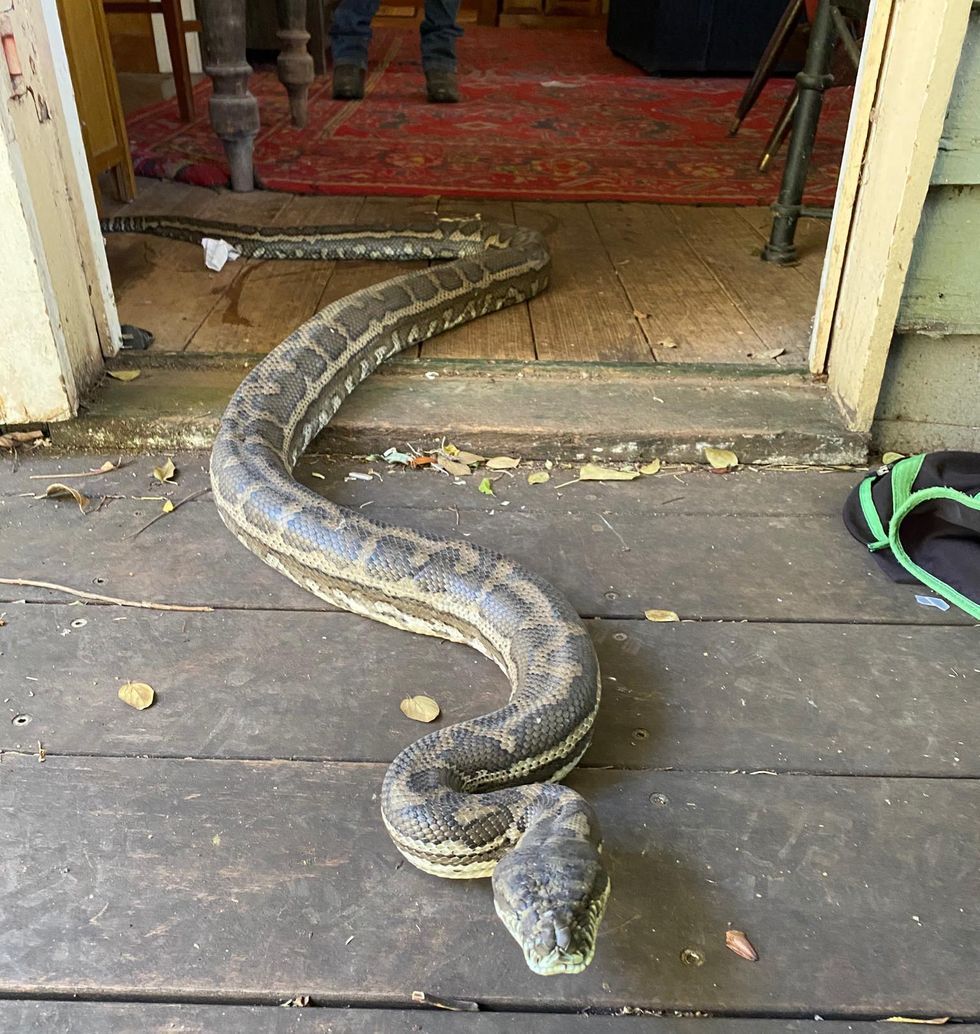
Excluding the title, the above narrative hits 110 words. Bit like 20-over cricket in reforming the classic short story which often dribbles on to being a short novel. Yes, the title of the segment is “lesion” – only one letter and one vowel eliminated away from “lesson”.
The Next Governor General
A few blogs ago, I suggested that the next Governor General should be an Aboriginal person. My vote would be for Tanya Denning Orman, described as a Birri (Queensland Channel Country) and Guugu Yimidhirr (Cooktown) woman from Central and North Queensland. She is vibrant – a person of the emerging generation who, in a five year tenure in Yarralumla, could do what the recent referendum failed to do. She could become a face of her people not only worrying over a Terra Cotta redress, but giving a vital interpretation of what it is to be an Australian, a true exemplar of hybrid vigour.
 Another worthy contender is Narelda Jacobs OAM, a Whadjuk Noongar woman who is a journalist and presenter on SBS. As has been said about her, she is someone who really understands the responsibility that comes with being seen. Neralda’s mother was a northern Irish immigrant and the founder of the first Noongar Church in Perth; her father was a Whadjuk Noongar man and a pastor who taught his five mixed race daughters that they “belonged anywhere”.
Another worthy contender is Narelda Jacobs OAM, a Whadjuk Noongar woman who is a journalist and presenter on SBS. As has been said about her, she is someone who really understands the responsibility that comes with being seen. Neralda’s mother was a northern Irish immigrant and the founder of the first Noongar Church in Perth; her father was a Whadjuk Noongar man and a pastor who taught his five mixed race daughters that they “belonged anywhere”.
The suggestion has been made that Linda Burney should replace the current incumbent, the strange serviceman with the tinkling wife, and restore some relevance to the post of Governor-General is a firm “no”.
In my lifetime, the value of the post has been reflected by the individual’s ability. Ninian Stephens, William Deane, Bill Hayden were all great men. Quentin Bryce – the first woman to be appointed Governor-General, with whom I once clashed in a medical ethics forum in my only encounter – I grudgingly admire although I’m unsure of her legacy.
If it is true that the Government is seriously considering Linda Burney for the role, it would be a grave mistake at a time when the Aboriginal people need a different role model to lead their cause. Linda Burney, as the Minister for Aboriginal Affairs, showed how inadequate she was during the Referendum campaign. She needed to do a lot more than sloganize. Now is the time for strong leadership, especially given the reaction of the Australian community to the referendum.
Let’s face it, giving her a five-year retirement package would be to miss an opportunity, but given the way the NSW Branch of the Labor Party functions it would be its classic Lilliputian way of doing anything.
Rumours are that Burney has a heart condition, which added to her other shortcomings, would not augur well for what should be a positive contribution to the future of the Aboriginal people, especially given the reaction of the Australian community.
Assuming the Burney becomes a non-runner, it is then time for the next Governor-General to take a leaf out of the Nelson Mandela workbook, rather than that of Malcolm X. I have advanced two names; but those who could select these or any other young Aboriginal women should realise the opportunity that must not be missed.
Mouse Whisper
When you people believe Netanyahu is out to exterminate every Gazan, you realise us mice are liable to be collateral damage, especially when you belong to a species of mice found only in Gaza.
I did not know about them until one of them left his mouse pad out. They are a sept of us house mice discovered by human scientists about 15 years ago in Gaza. These mice are distinguished from other mice by their light and dark brown colour with white big patches on the fur. The new subspecies was named “Muscles” Gazaensis. Presumably to survive they will follow the Hamas into the tunnels, but unsurprisingly we have not heard from them lately. However, we mice have strong survival instincts.

